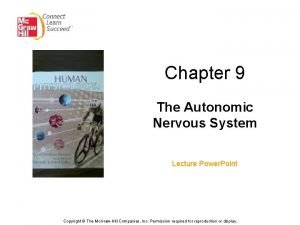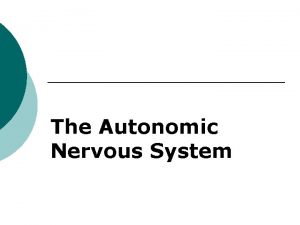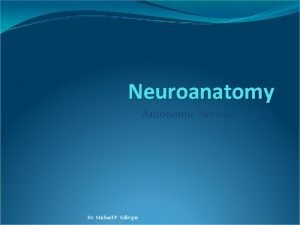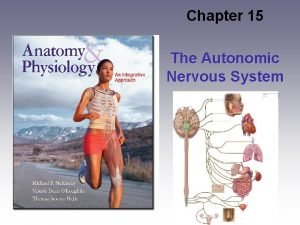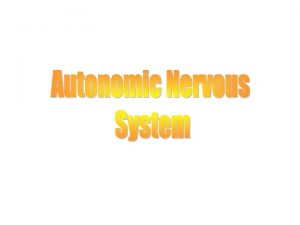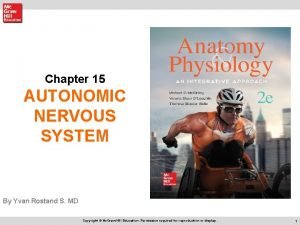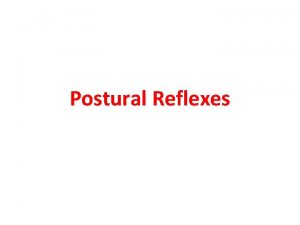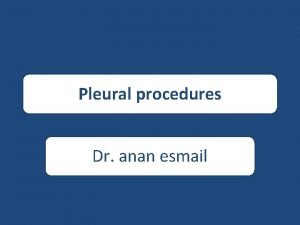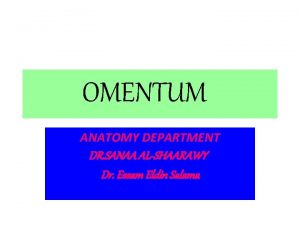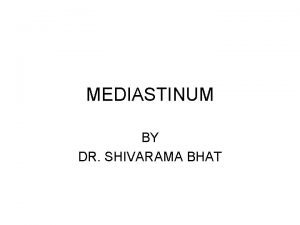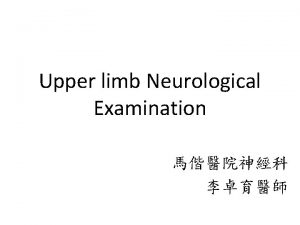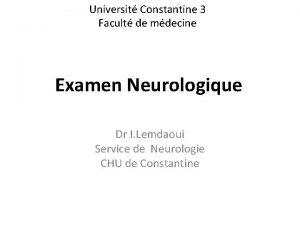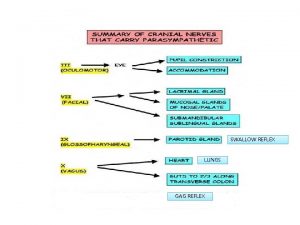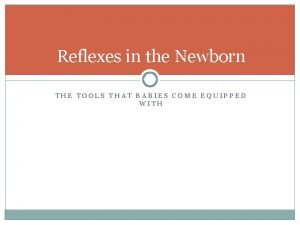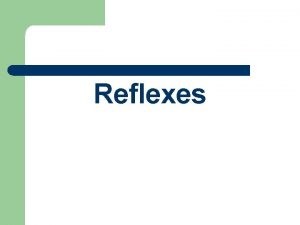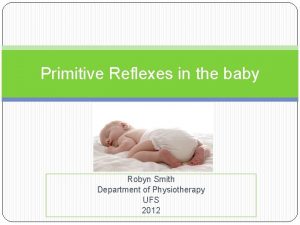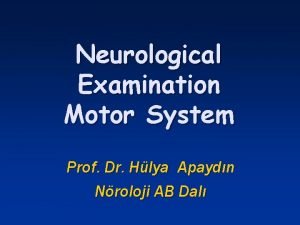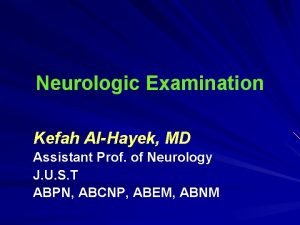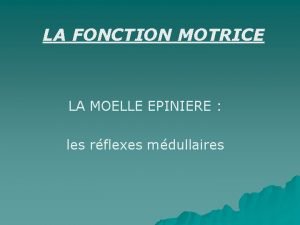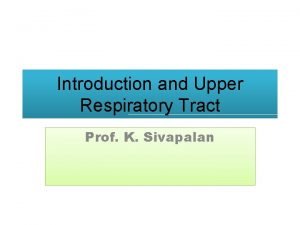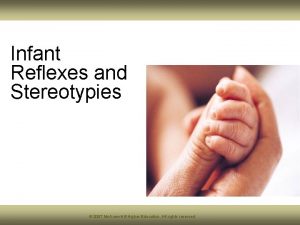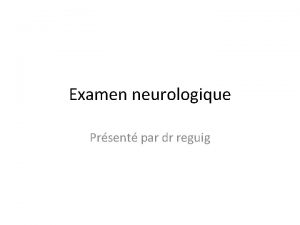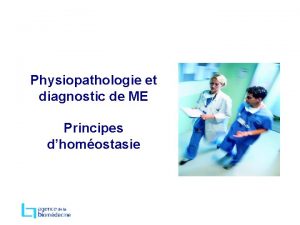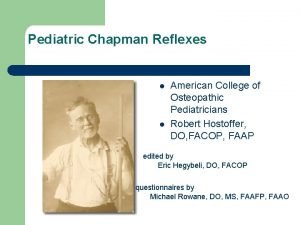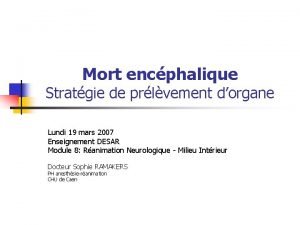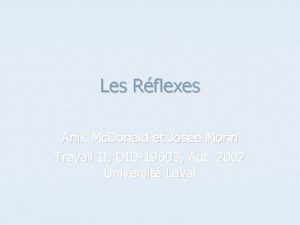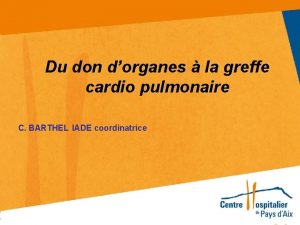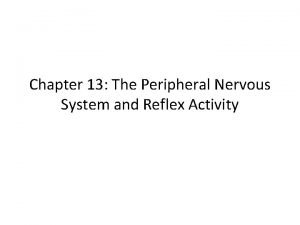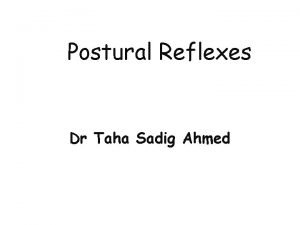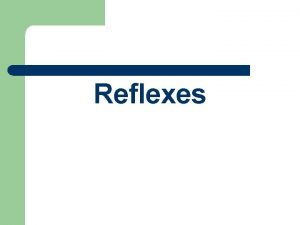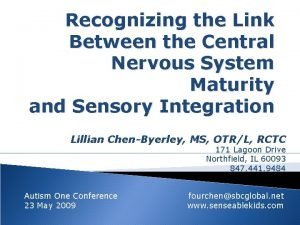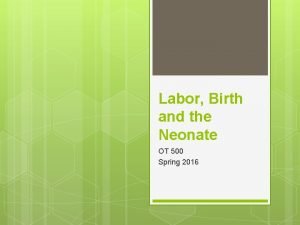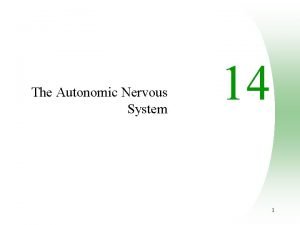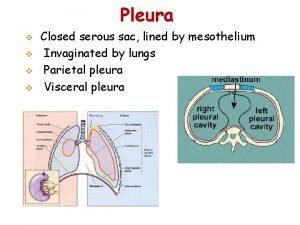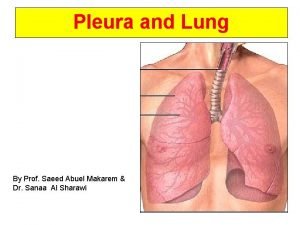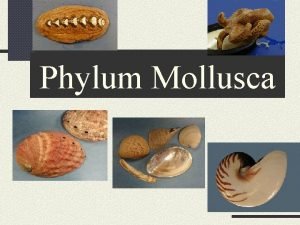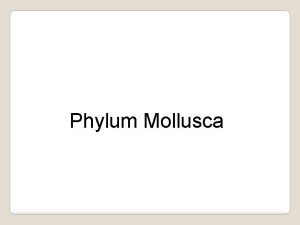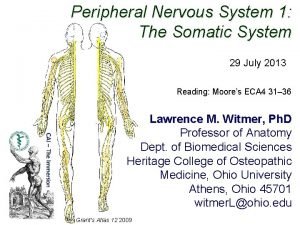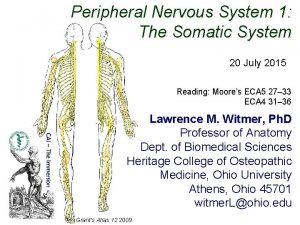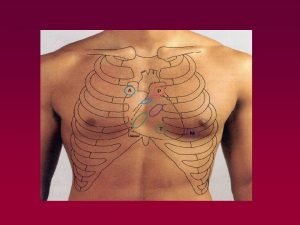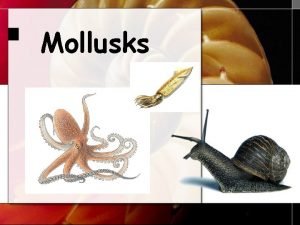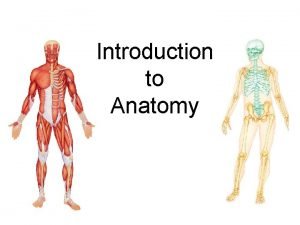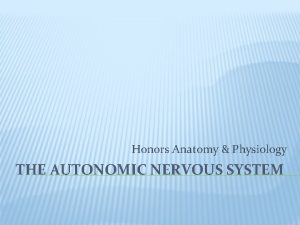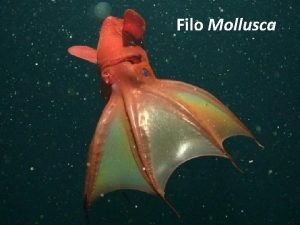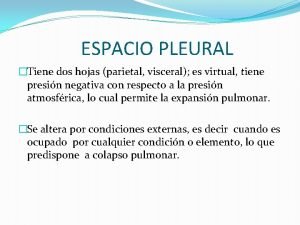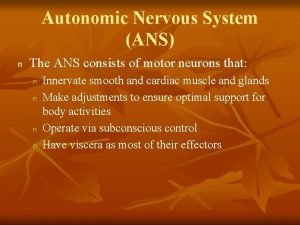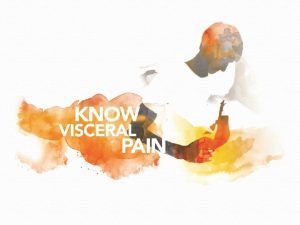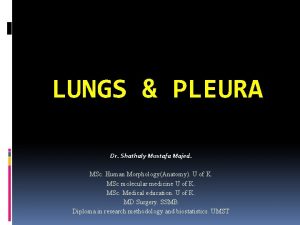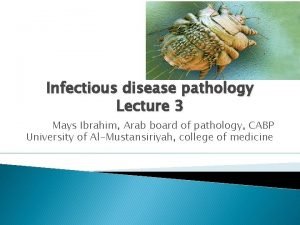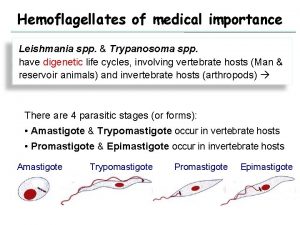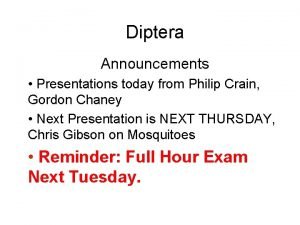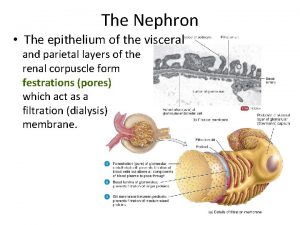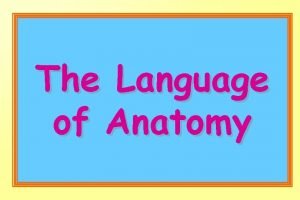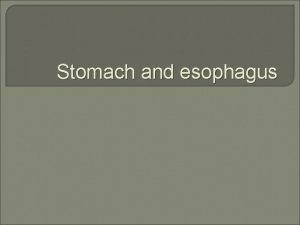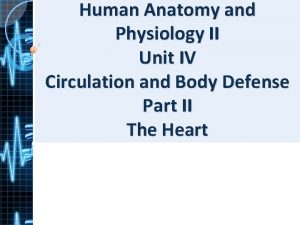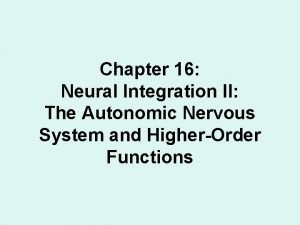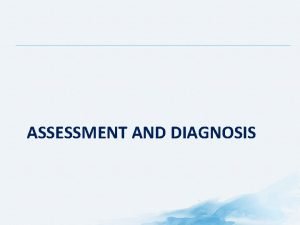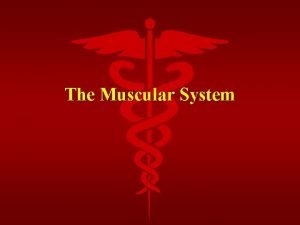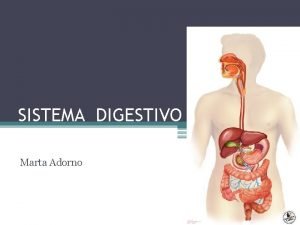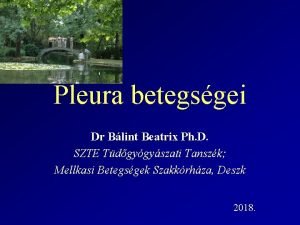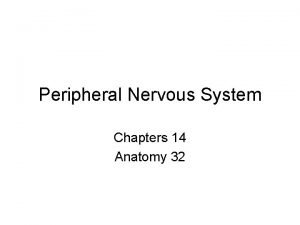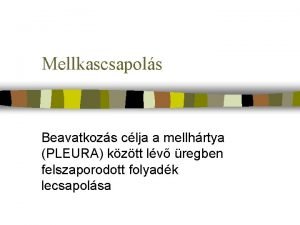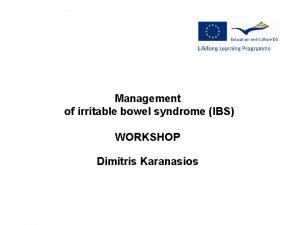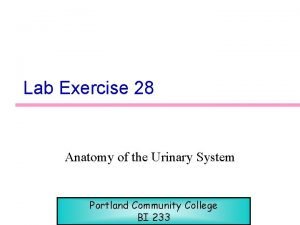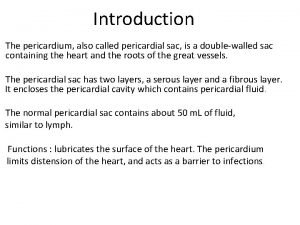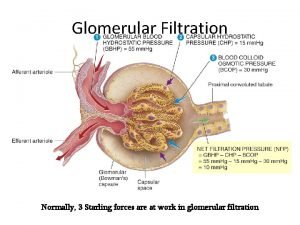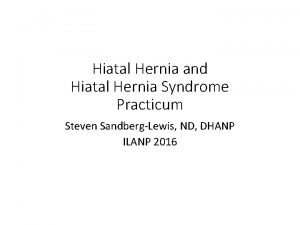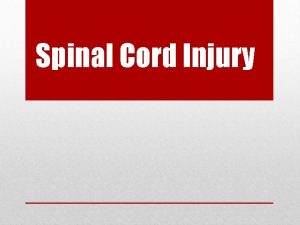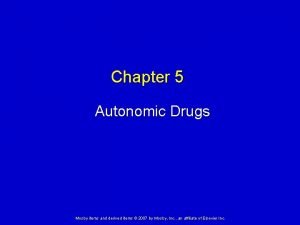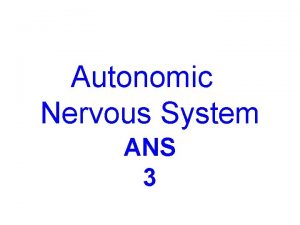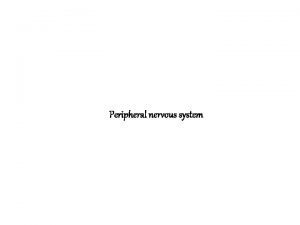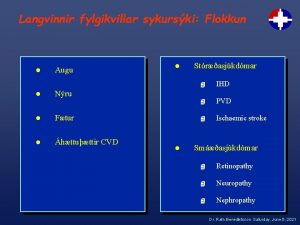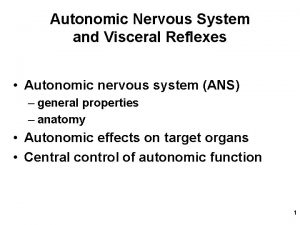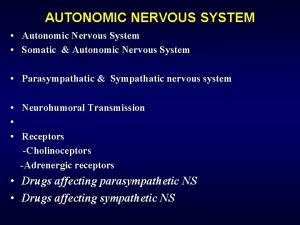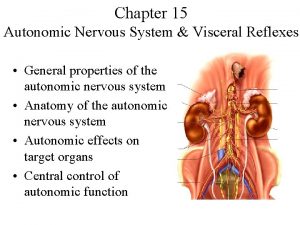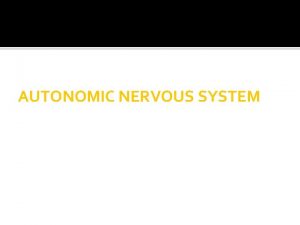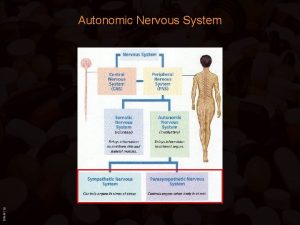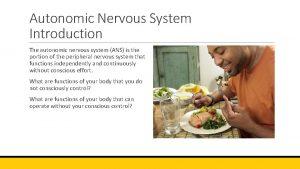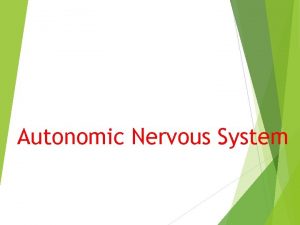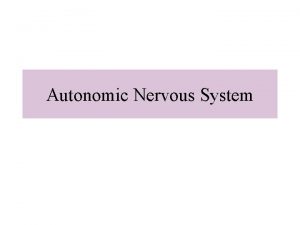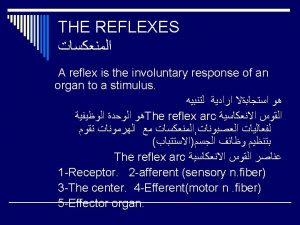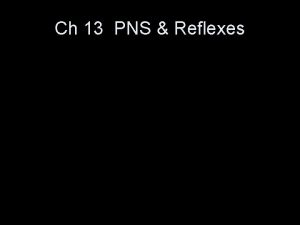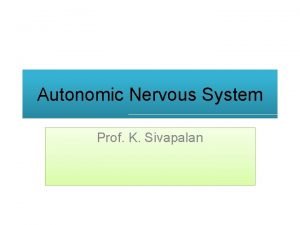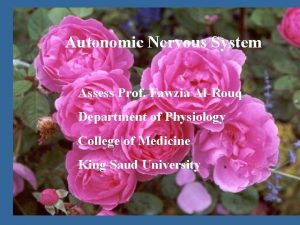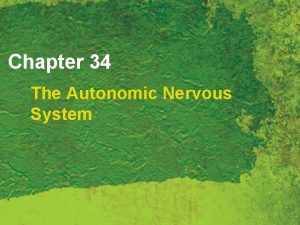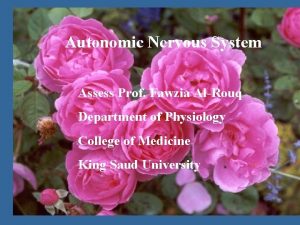Autonomic Nervous System and Visceral Reflexes Autonomic nervous














































































































- Slides: 110

Autonomic Nervous System and Visceral Reflexes • Autonomic nervous system (ANS) – general properties – anatomy • Autonomic effects on target organs • Central control of autonomic function 1

ANS - General Properties • Motor nervous system controls glands, cardiac and smooth muscle – also called visceral motor system • Regulates unconscious processes that maintain homeostasis – BP, body temperature, respiratory airflow • ANS actions are automatic – biofeedback techniques • train people to control hypertension, stress and migraine headaches 2

Visceral Reflexes • Unconscious, automatic responses to stimulation of glands, cardiac or smooth muscle 1. Receptors – detect internal stimuli -- stretch, blood chemicals, etc. 2. Afferent neurons – connect to interneurons in the CNS 3. Efferent neurons – carry motor signals to effectors – ANS is the efferent neurons of these reflex arcs 4. Effectors – glands, smooth or cardiac muscle • ANS modifies effector activity 3

Divisions of ANS • Two divisions innervate same target organs – may have cooperative or contrasting effects 1. Sympathetic division – prepares body for physical activity • increases heart rate, BP, airflow, blood glucose levels, etc 2. Parasympathetic division – – • • calms many body functions and assists in bodily maintenance digestion and waste elimination Autonomic tone is the normal rate of activity that represents the balance of the two systems Effects of each depend upon neurotransmitters released 4

Sympathetic Nervous System • Origin of presynaptic neurons – lateral horns of spinal cord (T 1 -L 2) • Sympathetic chain ganglia (paravertebral) – 3 cervical, 11 thoracic, 4 lumbar, 4 sacral and 1 coccygeal ganglia – white and gray communicating rami suspend ganglia from spinal nerve – pathways of preganglionic fibers 1. enter ganglia and synapse on postganglionic cell 2. travel to higher or lower ganglia and synapse 3. pass through chain without synapsing to reach collateral ganglia via splanchnic nerves 5

Sympathetic Nervous System • Neuronal divergence predominates – each preganglionic cell branches and synapses on multiple postganglionic cells – produces widespread effects on multiple organs 6

Efferent Pathways 7

Preganglionic Pathways 8

Parasympathetic Nervous System • Origin of preganglionic fibers – pons and medulla (for cranial nerve nuclei) – sacral spinal cord segments S 2 -S 4 • Pathways of preganglionic fibers – cranial nerves III, VII, IX and X – arising from sacral spinal cord • pelvic splanchnic nerves and inferior hypogastric plexus • Terminal ganglia in/near target organs – long preganglionic, short postganglionic fibers 9

Efferent Pathways 10

Parasympathetic Cranial Nerves • Oculomotor nerve (III) – narrows pupil and focuses lens • Facial nerve (VII) – tear, nasal and salivary glands • Glossopharyngeal (IX) – parotid salivary gland • Vagus nerve (X) – viscera as far as proximal half of colon – Cardiac, pulmonary, and esophageal plexus 11

Neurotransmitters and Receptors • Effects of ANS – determined by types of neurotransmitters released and types of receptors on target cells • Sympathetic has longer lasting effects – neurotransmitters persist in synapse and some reach the bloodstream • Many substances released as neurotransmitters – enkephalin, substance P, neuropeptide Y, neurotensin, nitric oxide (NO) • NO inhibits muscle tone in BV walls (vasodilation) 12

Neurotransmitters and Receptors 13

Cholinergic Receptors for ACh • Acetylcholine (Ach) binds to 2 classes of receptors 1. nicotinic receptors • • on all ANS postganglionic neurons, in the adrenal medulla, and at neuromuscular junctions (skeletal muscle) excitatory when ACh binding occurs 2. muscarinic receptors • • on all gland, smooth muscle and cardiac muscle cells that receives cholinergic innervation excitatory or inhibitory due to subclasses of muscarinic receptors 14

Adrenergic Receptors for NE • Norepinephrine binds to 2 classes of receptors – alpha adrenergic receptors (often excitatory) – beta adrenergic receptors (often inhibitory) • Exceptions – existence of subclasses of each receptor type • alpha 1 and 2; beta 1 and 2 • Function by means of 2 nd messengers – cyclic AMP and alpha 1 receptors 15

Dual Innervation • Most of viscera receive nerve fibers from both parasympathetic and sympathetic divisions • Both divisions do not normally innervate an organ equally 16

Dual Innervation • Antagonistic effects – oppose each other – exerted through dual innervation of same effector • heart rate decreases (parasympathetic) • heart rate increases (sympathetic) – exerted because each division innervates different cells • pupillary dilator muscle (sympathetic) dilates pupil • constrictor pupillae (parasympathetic) constricts pupil 17

Dual Innervation • Cooperative effects seen when 2 divisions act on different effectors to produce a unified effect – parasympathetics increase salivary serous cell secretion – sympathetics increase salivary mucous cell secretion 18

Dual Innervation of the Iris 19

Control of Autonomic Function • ANS regulated by several levels of CNS – cerebral cortex has an influence – hypothalamus (major visceral motor control center) • nuclei for primitive functions – hunger, thirst – midbrain, pons, and medulla oblongata • nuclei for cardiac and vasomotor control, salivation, swallowing, sweating, bladder control, and pupillary changes – spinal cord reflexes • defecation and micturition reflexes integrated in cord • brain can inhibit these responses consciously 20

Sense Organs • Sensory receptors – properties and types • General senses • Chemical senses • Hearing and equilibrium • Vision 21

Properties of Receptors • Sensory transduction – convert stimulus energy into nerve energy • Receptor potential – local electrical change in receptor cell • Adaptation – conscious sensation declines with continued stimulation 22

Receptors Transmit Information 1. Modality - type of stimulus 2. Location – – each sensory receptor receives input from its receptive field sensory projection - brain identifies site of stimulation 3. Intensity – frequency, number of fibers and which fibers 4. Duration - change in firing frequency over time – – phasic receptor - burst of activity and quickly adapt (smell and hair receptors) tonic receptor - adapt slowly, generate impulses continually (proprioceptor) 23

Receptive Fields 24

Classification of Receptors • By modality: – chemo-, thermo-, mechano-, photo- receptors and nociceptors • By origin of stimuli – interoceptors - detect internal stimuli – proprioceptors - sense body position and movements – exteroceptors - detect external stimuli • By distribution – general senses - widely distributed – special senses - limited to head 25

Unencapsulated Nerve Endings • Dendrites not wrapped in connective tissue • General sense receptors – for pain and temperature • Tactile discs – associated with cells at base of epidermis • Hair receptors – monitor movement of hair 26

Encapsulated Nerve Endings • Dendrites wrapped by glial cells or connective tissue – tactile corpuscles - phasic • light touch and texture – krause end bulb - phasic • tactile; in mucous membranes – lamellated corpuscles - phasic • deep pressure, stretch, tickle and vibration – ruffini corpuscles - tonic • heavy touch, pressure, joint movements and skin stretching 27

Somesthetic Projection Pathways • 1 st order neuron (afferent neuron) – from body, enter the dorsal horn of spinal cord via spinal nerves – from head, enter pons and medulla via cranial nerve – touch, pressure and proprioception on large, fast, myelinated axons – heat and cold on small, unmyelinated, slow fibers • 2 nd order neuron – decussation to opposite side in spinal cord or medulla/pons – end in thalamus, except for proprioception (cerebellum) • 3 rd order neuron – thalamus to primary somesthetic cortex of cerebrum 28

Pain • Nociceptors – allow awareness of tissue injuries – found in all tissues except the brain • Fast pain travels in myelinated fibers at 30 m/sec – sharp, localized, stabbing pain perceived with injury • Slow pain travels unmyelinated fibers at 2 m/sec – longer-lasting, dull, diffuse feeling • Somatic pain from skin, muscles and joints • Visceral pain from stretch, chemical irritants or ischemia of viscera (poorly localized) • Injured tissues release chemicals that stimulate pain fibers (bradykinin, histamine, prostaglandin) 29

Projection Pathway for Pain • General pathway – conscious pain – 1 st order neuron cell bodies in dorsal root ganglion of spinal nerves or cranial nerves V, VII, IX, and X – 2 nd order neurons decussate and send fibers up spinothalamic tract or through medulla to thalamus • gracile fasciculus carries visceral pain signals – 3 rd order neurons from thalamus reach primary somesthetic cortex as sensory homunculus • Spinoreticular tract – pain signals reach reticular formation, hypothalamus and limbic – trigger visceral, emotional, and behavioral reactions 30

Pain Signal Destinations 31

Referred Pain • Misinterpreted pain – brain “assumes” visceral pain is coming from skin – heart pain felt in shoulder or arm because both send pain input to spinal cord segments T 1 to T 5 32

Referred Pain 33

CNS Modulation of Pain • Intensity of pain - affected by state of mind • Endogenous opiods (enkephalins, endorphins and dynorphins) – produced by CNS and other organs under stress – in dorsal horn of spinal cord (spinal gating) – act as neuromodulators block transmission of pain 34

Spinal Gating • Stops pain signals at dorsal horn – descending analgesic fibers from reticular formation travel down reticulospinal tract to dorsal horn • secrete inhibitory substances that block pain fibers from secreting substance P • pain signals never ascend – dorsal horn fibers inhibited by input from mechanoreceptors • rubbing a sore arm reduces pain 35

Spinal Gating of Pain Signals 36

Chemical Sense - Taste • Gustation - sensation of taste – results from action of chemicals on taste buds • Lingual papillae – filiform (no taste buds) • important for texture – foliate (no taste buds) – fungiform • at tips and sides of tongue – vallate (circumvallate) • at rear of tongue • contains 1/2 of taste buds 37

Taste Bud Structure • Taste cells – apical microvilli serve as receptor surface – synapse with sensory nerve fibers at their base • Supporting cells • Basal cells 38

Physiology of Taste • • Molecules must dissolve in saliva 5 primary sensations - throughout tongue 1. 2. 3. 4. 5. • Influenced by food texture, aroma, temperature, and appearance – • Sweet - concentrated on tip Salty - lateral margins Sour - lateral margins Bitter - posterior Umami - taste of amino acids (MSG) mouthfeel - detected by lingual nerve in papillae Hot pepper stimulates free nerve endings (pain) 39

Physiology of Taste • Mechanisms of action – activate 2 nd messenger systems • sugars, alkaloids and glutamates bind to receptors – depolarize cells directly • sodium and acids penetrate cells 40

Projection Pathways for Taste • Innervation of taste buds – facial nerve (VII) - anterior 2/3’s of tongue – glossopharyngeal nerve (IX) - posterior 1/3 – vagus nerve (X) - palate, pharynx, epiglottis 41

Chemical Sense - Smell • Olfactory mucosa – contains receptor cells for olfaction – highly sensitive • up to 10, 000 odors – on 5 cm 2 of superior concha and nasal septum 42

Olfactory Epithelial Cells • Olfactory cells – olfactory hairs neurons with 20 cilia • bind odor molecules in thin layer of mucus – axons pass through cribriform plate – survive 60 days • Supporting cells • Basal cells – divide 43

Physiology of Smell • Molecules bind to receptor on olfactory hair – hydrophilic - diffuse through mucus – hydrophobic - transport by odorant-binding protein • Activate G protein and c. AMP system • Opens ion channels for Na+ or Ca 2+ – creates a receptor potential • Action potential travels to brain • Receptors adapt quickly – due to synaptic inhibition in olfactory bulbs 44

Olfactory Pathway • Olfactory cells synapse in olfactory bulb – on mitral and tufted cell dendrites – in spherical clusters called glomeruli • each glomeruli dedicated to single odor 45

The Nature of Sound • Sound - audible vibration of molecules – vibrating object pushes air molecules 46

Pitch and Loudness • Pitch - frequency vibrates specific parts of ear – hearing range is 20 (low pitch) - 20, 000 Hz (cycles/sec) – speech is 1500 -4000 where hearing is most sensitive • Loudness – amplitude; intensity of sound energy 47

Outer Ear 48

Outer Ear • Fleshy auricle (pinna) directs air vibrations down external auditory meatus – cartilagenous and bony, S-shaped tunnel ending at eardrum – glandular secretions and dead cells form cerumen (earwax) 49

Anatomy of Middle Ear 50

Middle Ear • Air-filled tympanic cavity in temporal bone between tympanic membrane and oval window – continuous with mastoid air cells • Contains – auditory tube (eustachian tube) connects to nasopharynx • equalizes air pressure on tympanic membrane – ear ossicles • malleus • incus • stapes – stapedius and tensor tympani muscles attach to stapes and malleus 51

Anatomy of Inner Ear 52

Inner Ear • Bony labyrinth - passageways in temporal bone • Membranous labyrinth - fleshy tubes lining bony tunnels – filled with endolymph (similar to intracellular fluid) – floating in perilymph (similar to cerebrospinal fluid) 53

Details of Inner Ear Fig. 16. 12 c 54

Details of Inner Ear 55

Anatomy of Cochlea • Scala media (cochlear duct) – separated from • scala vestibuli by vestibular membrane • scala tympani by basilar membrane • Spiral organ (organ of corti) 56

Spiral Organ 57

Spiral Organ • Stereocilia of hair cells attach to gelatinous tectorial membrane • Inner hair cells – hearing • Outer hair cells – adjust cochlear responses to different frequencies – increase precision 58

SEM of Cochlear Hair Cells 59

Physiology of Hearing - Middle Ear • Tympanic membrane – has 18 times area of oval window – ossicles transmit enough force/unit area at oval window to vibrate endolymph in scala vestibuli • Tympanic reflex – muscle contraction – tensor tympani m. tenses tympanic membrane – stapedius m. reduces mobility of stapes • best response to slowly building loud sounds • occurs while speaking 60

Stimulation of Cochlear Hair Cells • Vibration of ossicles causes vibration of basilar membrane under hair cells – as often as 20, 000 times/second 61

Cochlear Hair Cells • Stereocilia of OHCs – bathed in high K+ • creating electrochemical gradient – tips embedded in tectorial membrane – bend in response to movement of basilar membrane • pulls on tip links and opens ion channels • K+ flows in – depolarization causes release of neurotransmitter • stimulates sensory dendrites at base 62

Potassium Gates 63

Sensory Coding • Vigorous vibrations excite more inner hair cells over a larger area – triggers higher frequency of action potentials – brain interprets this as louder sound • Pitch depends on which part of basilar membrane vibrates – at basal end, membrane narrow and stiff • brain interprets signals as high-pitched – at distal end, 5 times wider and more flexible • brain interprets signals as low-pitched 64

Basilar Membrane Frequency Response Notice high and low frequency ends 65

Cochlear Tuning • Increases ability of cochlea to receive some sound frequencies • Outer hair cells contract reducing basilar membranes freedom to vibrate – fewer signals from that area allows brain to distinguish between more and less active areas of cochlea • Pons has inhibitory fibers that synapse near the base of IHCs – increases contrast between regions of cochlea 66

Innervation of Internal Ear • Vestibular ganglia - visible in vestibular nerve • Spiral ganglia - buried in modiolus of cochlea 67

Auditory Pathway 68

Auditory Projection Pathway • Spiral ganglion formed by cell bodies of sensory neurons • Axons form cochlear nerve portion of CN VIII • Synapse in cochlear nuclei • Binaural hearing – superior olivary nucleus compares sounds from both sides to identify direction • Inferior colliculus helps – locate origin of sound – process fluctuations in pitch during speech – produce startle response; head turning to loud sound • Fibers from inferior colliculus go to primary auditory cortex – temporal lobe 69

Equilibrium • Control of coordination and balance • Receptors in vestibular apparatus – semicircular ducts contain crista – saccule and utricle contain macula • Static equilibrium – perceived by macula – perception of head orientation • Dynamic equilibrium – perception of motion or acceleration • linear acceleration perceived by macula • angular acceleration perceived by crista 70

Saccule and Utricle • Contain macula – hair cells with stereocilia and one kinocilium buried in a gelatinous otolithic membrane – otoliths add to the density and inertia and enhance the sense of gravity and motion 71

Macula • • Static equilibrium - when head is tilted, weight of membrane bends the stereocilia Dynamic equilibrium – in car, linear acceleration detected as otoliths lag behind 72

Crista ampullaris • Consists of hair cells buried in a mound of gelatinous membrane (one in each duct) • Orientation causes ducts to be stimulated by rotation in different planes 73

Crista Ampullaris - Head Rotation • As head turns, endolymph lags behind, pushes cupula, stimulates hair cells 74

Equilibrium Projection Pathways • Hair cells of macula sacculi, macula utriculi and semicircular ducts synapse on vestibular nerve • Fibers end in vestibular nucleus in pons and medulla 75

Vision and Light • Vision - perception of light emitted or reflected from objects in the environment • Visible light – electromagnetic radiation with wavelengths from 400 to 750 nm – must cause a photochemical reaction to produce a nerve signal • radiation below 400 nm; energetic, kills cells • radiation above 750 nm; too little energy to cause photochemical reaction 76

External Anatomy of Eye 77

Eyebrows and Eyelids • Eyebrows provide facial expression • Eyelids (palpebrae) – block foreign objects, help with sleep, blink to moisten – meet at corners (commissures) – consist of orbicularis oculi muscle and tarsal plate covered with skin outside and conjunctiva inside – tarsal glands secrete oil that reduces tear evaporation – eyelashes help keep debris from eye 78

Conjunctiva • Transparent mucous membrane lines eyelids and covers anterior surface of eyeball except cornea • Richly innervated and vascular (heals quickly) 79

Lacrimal Apparatus • Tears flow across eyeball help to wash away foreign particles, help with diffusion of O 2 and CO 2 and contain bactericidal enzyme 80

Tunics of the Eyeball • Fibrous layer - sclera and cornea • Vascular layer - choroid, ciliary body and iris • Internal layer - retina and optic nerve 81

Optical Components • Structures refract light to focus on retina – cornea • transparent cover on anterior surface of eyeball – aqueous humor • serous fluid posterior to cornea, anterior to lens – lens • changes shape to help focus light – rounded with no tension – flattened due to pull of suspensory ligaments – vitreous humor • jelly fills space between lens and retina 82

Aqueous Humor • Produced by ciliary body, flows to posterior chamber through pupil to anterior chamber - reabsorbed into canal of Schlemm 83

Neural Components • Includes retina and optic nerve • Retina – forms as an outgrowth of the diencephalon – attached at optic disc and at ora serrata – pressed against rear of eyeball by vitreous 84

Formation of an Image • Light passes through lens to form inverted image on retina • Pupillary constrictor - smooth muscle encircling the pupil – parasympathetic stimulation narrows pupil • Pupillary dilator - spokelike myoepithelial cells – sympathetic stimulation widens pupil • Active when light intensity changes or gaze shifts from distant object to nearby object – photopupillary reflex -- both pupils constrict if one eye is illuminated (type of consensual reflex) 85

Principle of Refraction Light striking the lens or cornea at a 90 degree angle is not bent. 86

Refraction • Bending of light rays occurs when light passes through substance with different refractive index at any angle other than 90 degrees – refractive index of air is arbitrarily set to n = 1 – refractive index • cornea is n = 1. 38 • lens is n = 1. 40 • Cornea refracts light more than lens does – due to shape of cornea – lens becomes rounder to increase refraction for near vision 87

Near Response • Allows eyes to focus on nearby object (that sends oblique light waves to eyes) 1. convergence of eyes • eyes orient their visual axis towards object 2. constriction of pupil • blocks peripheral light rays and reduces spherical aberration (blurry edges) 3. accomodation of lens • ciliary muscle contracts, lens takes convex shape – light refracted more strongly and focused onto retina 88

Emmetropia and Near Response Fig. 16. 31 a Distant object Close object 89

Emmetropia and Near Response 90

Accommodation of Lens 91

Effects of Corrected Lenses • Hyperopia - farsighted (eyeball too short) – correct with convex lenses • Myopia - nearsighted (eyeball too long) – correct with concave lenses 92

Photoreceptor Cells • Posterior layer of retina - pigment epithelium – purpose is to absorb stray light and prevent reflections • Photoreceptors – rod cells (night - scotopic vision) • outer segment - stack of coinlike membranous discs studded with rhodopsin pigment molecules – cone cells (color - photopic vision) • outer segment tapers to a point 93

Histology - Layers of Retina 94

Location of Visual Pigments 95

Nonreceptor Retinal Cells • Bipolar cells (1 st order neurons) – synapse on ganglion cells – large amount of convergence • Ganglion cells (2 nd order neurons) – axons of these form optic nerve – more convergence occurs (114 receptors to one optic nerve fiber) • Horizontal and amacrine cells form connections between other cells – enhance perception of contrast, edges of objects and changes in light intensity 96

Schematic Layers of the Retina 97

Visual Pigments • Rod cells have rhodopsin – has absorption peak at wavelength of 500 nm – 2 major parts of molecule • opsin - protein portion • retinal - a vitamin A derivative • Cones contain photopsin (iodopsin) – opsin moieties contain different amino acids that determine wavelengths of light absorbed – 3 kinds of cones absorbing different wavelengths of light produce color vision 98

Rhodopsin Bleaching/Regeneration • Rhodopsin absorbs light, converted from bent shape (cis-retinal) to straight (trans-retinal) – retinal dissociates from opsin (bleaching) – 5 minutes to regenerate 50% of bleached rhodopsin 99

Generating Visual Signals 100

Generating Nerve Signals - Rods • In the dark, rods exhibit a dark signal – flow of Na+ and release of neurotransmitter (glutamate) • depolarization by Na+ stimulates glutamate release • In the light, dark current and glutamate release stops – bleached rhodopsin molecule acts like an enzyme and breaks down c. GMP molecules – Na+ gates close and dark current ceases (inhibition stops), nerve signal results 101

Bipolar Cell Function • Two kinds of bipolar cells – inhibited (hyperpolarized) by glutamate • excited by rising light intensity – excited (depolarized) by glutamate • excited by falling light intensity • As your eye scans a scene, areas of light and dark cause a changing pattern of bipolar cell responses • Variable pattern of stimulation of ganglion cells and nerve signals sent to the brain 102

Light and Dark Adaptation • Light adaptation (walk out into sunlight) – pupil constriction and pain from over stimulated retinas – color vision and acuity below normal for 5 to 10 minutes • Dark adaptation (turn lights off) – dilation of pupils occurs – 20 to 30 minutes required for regeneration of rhodopsin 103

Duplicity Theory • Explains why we have both rods and cones • Single type of receptor cell incapable of providing high sensitivity and high resolution – sensitive night vision = one type of cell and neural circuitry – high resolution daytime vision = different cell type and neuronal circuitry 104

Duplicity Theory 105

Scotopic System (Night Vision) • Rods sensitive – react even in dim light – extensive neuronal convergence – 600 rods converge on 1 bipolar cell – many bipolar converge on each ganglion cell – results in high degree of spatial summation • one ganglion cells receives information from 1 mm 2 of retina producing only a coarse image • Edges of retina have widely-spaced rod cells, act as motion detectors 106

Photopic System (Day Vision) • Fovea contains only 4000 tiny cone cells (no rods) – no neuronal convergence – each foveal cone cell has “private line to brain” • High-resolution color vision – little spatial summation so less sensitivity to dim light 107

Color Vision • Primates have well developed color vision – nocturnal vertebrates have only rods • Cones named for absorption peaks of photopsins – blue cones peak sensitivity at 420 nm – green cones peak at 531 nm – red cones peak at 558 nm (orange-yellow) • Color perception based on mixture of nerve signals 108

Stereoscopic Vision (Stereopsis) • Depth perception - ability to judge distance to objects – requires 2 eyes with overlapping visual fields – panoramic vision has eyes on sides of head (horse) • Fixation point – farther away requires image focus medial to fovea – closer results in image focus lateral to fovea 109

Visual Projection Pathway • Bipolar and ganglion cells in retina - 1 st and 2 nd order neurons (ganglion cell axons of form CN II) • Hemidecussation in optic chiasm – 1/2 of fibers decussate so that images of all objects in left visual field fall on right half of each retina – each side of brain sees what is on side where it has motor control over limbs • 3 rd order neurons in lateral geniculate nucleus of thalamus form optic radiation to 1 visual cortex where conscious visual sensation occurs • Few fibers project to superior colliculi and midbrain for visual reflexes (photopupillary and accomodation) 110
 Visceral nervous system
Visceral nervous system Adrenergic receptors sympathetic or parasympathetic
Adrenergic receptors sympathetic or parasympathetic Autonomic reflexes
Autonomic reflexes Autonomic motor neurons regulate visceral activities by
Autonomic motor neurons regulate visceral activities by Parasympathetic preganglionic neurons
Parasympathetic preganglionic neurons Autonomic receptors
Autonomic receptors Somatic nervous system
Somatic nervous system Sympathetic tone definition
Sympathetic tone definition Somatic nervous system
Somatic nervous system Autonomic nervous system consists of
Autonomic nervous system consists of Ganglion on spine
Ganglion on spine Autonomic nervous system
Autonomic nervous system The autonomic nervous system controls
The autonomic nervous system controls Autonomic dysreflexia
Autonomic dysreflexia Label the different types of neuronal pools in the figure.
Label the different types of neuronal pools in the figure. Sensory input and motor output
Sensory input and motor output Processes of a neuron
Processes of a neuron Autonomic nerveous system
Autonomic nerveous system Nervous system and digestive system
Nervous system and digestive system Adh function
Adh function Endocrine system and nervous system
Endocrine system and nervous system Air righting reflex
Air righting reflex Unconditioned reflex
Unconditioned reflex Transudative pleural effusion
Transudative pleural effusion Omentum
Omentum Pathway of food from mouth to anus
Pathway of food from mouth to anus Peritoneal cavity vs abdominal cavity
Peritoneal cavity vs abdominal cavity Oblique sinus
Oblique sinus Endocrine vs nervous system venn diagram
Endocrine vs nervous system venn diagram Power lower limb
Power lower limb Force musculaire cotation
Force musculaire cotation Gag swallow reflexes
Gag swallow reflexes Newborn reflexes
Newborn reflexes Brisk reflex means
Brisk reflex means Landau reflex
Landau reflex Dr abdel
Dr abdel Reflex grading
Reflex grading Muscle strength grading 1-5
Muscle strength grading 1-5 Infant reflexes chart
Infant reflexes chart Teratogens examples
Teratogens examples Organes tendineux de golgi
Organes tendineux de golgi Acute upper respiratory infection unspecified คือ
Acute upper respiratory infection unspecified คือ Infant reflexes chart
Infant reflexes chart Force musculaire cotation
Force musculaire cotation Rooting reflex
Rooting reflex Reflexes du tronc
Reflexes du tronc Anterior chapman points
Anterior chapman points Reflexes du tronc
Reflexes du tronc Reflexes du tronc
Reflexes du tronc Reflexes du tronc
Reflexes du tronc Muscle spindle
Muscle spindle Placing reflex
Placing reflex Pns
Pns Superficial reflexes
Superficial reflexes Labyrinthine reflexes
Labyrinthine reflexes Brain stem reflexes ppt
Brain stem reflexes ppt Neonatal reflexes
Neonatal reflexes Reflex grading
Reflex grading Superior duodenal recess
Superior duodenal recess Heart membranes
Heart membranes Somatic reflex vs visceral reflex
Somatic reflex vs visceral reflex Visceral leishmaniasis
Visceral leishmaniasis Diaphragmatic recess
Diaphragmatic recess Nerve supply to pleura
Nerve supply to pleura Gastropoda
Gastropoda Mollusca symmetry
Mollusca symmetry Visceral vs somatic sensory
Visceral vs somatic sensory Klumpke palsy
Klumpke palsy Conducting system heart
Conducting system heart Estrutura corporal dos moluscos
Estrutura corporal dos moluscos Mollusca
Mollusca Protraction in anatomy
Protraction in anatomy Ans
Ans Sistema fonatório
Sistema fonatório A pérola é uma secreção do manto ou pálio.
A pérola é uma secreção do manto ou pálio. Neumotórax
Neumotórax Somatic reflex vs visceral reflex
Somatic reflex vs visceral reflex Dolor referido
Dolor referido Reflex
Reflex Pleura parietal visceral
Pleura parietal visceral Perforation peritonitis
Perforation peritonitis Visceral leishmaniasis
Visceral leishmaniasis Diptera
Diptera Fluid volume
Fluid volume Erect anatomical position
Erect anatomical position What is peristalsis movement
What is peristalsis movement Visceral pericardium
Visceral pericardium Visceral reflex
Visceral reflex Vulvodynia symptoms pictures
Vulvodynia symptoms pictures Peritoneal cavity where is it
Peritoneal cavity where is it Visceral muscle
Visceral muscle Orgaos acessorios sistema digestivo
Orgaos acessorios sistema digestivo Tenziós ptx
Tenziós ptx Cervical plexus
Cervical plexus Mellkaspunctio
Mellkaspunctio Visceral hypersensitivity
Visceral hypersensitivity Macula densa cells
Macula densa cells Identify
Identify Visceral layer of serous pericardium
Visceral layer of serous pericardium Visceral layer
Visceral layer Sdash diet
Sdash diet Hiatus defenition
Hiatus defenition Anal wink reflex
Anal wink reflex Autonomic network management
Autonomic network management An architectural blueprint for autonomic computing
An architectural blueprint for autonomic computing Mosby items and derived items
Mosby items and derived items Autonomic drugs
Autonomic drugs The vision of autonomic computing
The vision of autonomic computing Autonomic state
Autonomic state Autonomic computing ibm
Autonomic computing ibm Diabetic autonomic neuropathy
Diabetic autonomic neuropathy

